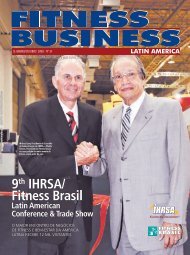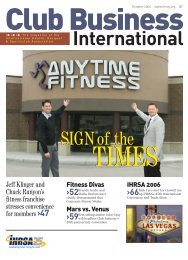Innovations - IHRSA
Innovations - IHRSA
Innovations - IHRSA
You also want an ePaper? Increase the reach of your titles
YUMPU automatically turns print PDFs into web optimized ePapers that Google loves.
John Ratey, M.D.<br />
By Patricia Amend<br />
CBI: You’ve written eight books and lectured on exercise and the brain,<br />
throughout the world, for many years. What attracted you to this area<br />
of research?<br />
DR. John RatEy: When I graduated from college in 1970, and decided that I wanted<br />
to become a doctor, researchers were just beginning to suspect that the brain might<br />
have something to do with the psyche. Interest in the study of neuropsychiatry was<br />
rising, so, in medical school, I took all of the related courses that I could, and I just<br />
loved them.<br />
I’ve always been intrigued by how the brain, its natural chemicals, and the drugs<br />
we take play a role in personality. For example, during my residency, I discovered<br />
that beta blockers, which are heart drugs, have a profound effect on aggression<br />
and self-abusive behavior. I received grants to study related areas, and developed<br />
an interest in attention deficit hyperactive disorder (ADHD). Eventually, I began to<br />
lecture on aggression, autism, and ADHD. I knew that exercise had a huge impact<br />
on these disorders, and began to follow the related literature, sparse as it was at<br />
the time.<br />
CBI: The Surgeon General’s Report on Physical Activity and Health, published<br />
in 1996, contained little about the effects of exercise on the brain. When was<br />
the connection first clearly identified?<br />
JR: In 1995, researchers began to study exercise and its effect on Alzheimer’s disease<br />
and our cognitive ability as we age. The field started to explode, and, today, it’s one<br />
of the most popular areas in neuroscience. By 2000, there was so much to say that I<br />
wrote A User’s Guide to the Brain to explain how the brain works to the general public.<br />
Like all of my books, this one has a heavy emphasis on exercise. Since then, I’ve been<br />
lecturing about exercise and its effect on mood, cognition, anxiety, attention, addictions,<br />
and aging. As a result, exercise has come to be regarded as a treatment.<br />
CBI: In your latest book, Spark: The Revolutionary New Science of Exercise and<br />
the Brain, you begin by talking about the physical-education (PE) program in<br />
the public schools in Naperville, Illinois. What intrigued you about it?<br />
JR: I’d been looking for a simple way to illustrate the effects of exercise on learning<br />
in children. Naperville provides a powerful case study on how aerobic activity can<br />
transform not only the body, but the mind as well. The Naperville 203 School District<br />
has 14 elementary schools, five junior high schools, and two high schools, for a total<br />
of 19,000 kids; and, for the last 18 years, it’s offered students a fitness-based PE<br />
program. The kids can choose from among 18 activities—from using an exercise<br />
bike with a video monitor, to running on a treadmill, to scaling climbing walls, to<br />
playing various sports. The key is that they wear heart-rate monitors and focus not<br />
on how well they perform the activity, but, rather, on how much time they spend ><br />
| CBI Interview |<br />
The renowned psychiatrist and best-selling author shares startling<br />
new findings about the dramatic effects of exercise on the brain<br />
Highlights<br />
» ‘Smart’ to exercise<br />
» The benefits of PE<br />
» The brain: a muscle?<br />
» Prescribing exercise<br />
John Ratey, M.D., earned<br />
a bachelor’s degree in philosophy<br />
from Colgate University;<br />
studied premedical sciences<br />
at Northeastern University,<br />
Harvard University, and Boston<br />
University; and received<br />
his M.D., from the University<br />
School of Medicine. He’s an<br />
associate clinical professor of<br />
psychiatry at Harvard Medical<br />
School, a research synthesizer,<br />
speaker, and author, and<br />
maintains a private practice.<br />
He’s lectured and published<br />
60 peer-reviewed articles on<br />
aggression, autism, ADHD,<br />
and other neuropsychiatric<br />
issues, and has edited several<br />
textbooks. He’s also authored<br />
or co-authored eight books,<br />
including A User’s Guide to the<br />
Brain (2000); Shadow Syndromes<br />
(1997) with Catherine Johnson,<br />
Ph.D.; Driven to Distraction<br />
(1994); Answers to Distraction<br />
(1995); Delivered from Distraction<br />
(2005) with Edward Hallowell,<br />
M.D.; and Spark: The<br />
Revolutionary New Science of<br />
Exercise and the Brain (2008)<br />
with Eric Hagerman. —|<br />
www.ihrsa.org | APrIL 2010 | Club Business International 25
















